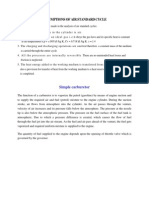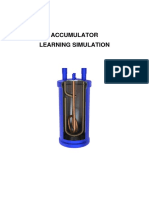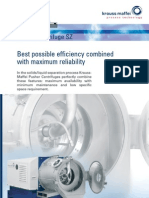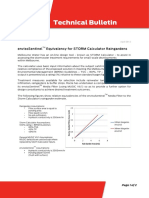Accumulator Operation and Applications
Accumulator Operation and Applications
Uploaded by
Chockalingam AthilingamCopyright:
Available Formats
Accumulator Operation and Applications
Accumulator Operation and Applications
Uploaded by
Chockalingam AthilingamOriginal Description:
Copyright
Available Formats
Share this document
Did you find this document useful?
Is this content inappropriate?
Copyright:
Available Formats
Accumulator Operation and Applications
Accumulator Operation and Applications
Uploaded by
Chockalingam AthilingamCopyright:
Available Formats
Accumulator Operation and Applications
What is an accumulator?
An accumulator is an energy storage device. It stores potential energy through the compression of
a dry inert gas (typically nitrogen) in a container open to a relatively incompressible fluid (typically
hydraulic oil). There are two types of accumulators commonly used today. The first is the bladder
type (including diaphragm designs) and the second is the piston type. While other types of
accumulator designs exist, compressed gas accumulators ar far and away the most common.
The bladder style uses a compressible gas contained in an elastic bladder mounted inside a shell.
The shell acts as a pressure container for both the gas (in the bladder) and the hydrauic fluid. The
bladder provides the barrier between the inert gas and the fluid to prevent intermixing. The piston
style uses a cylinder with a floating piston. The cylinder serves as the pressure container for both
the gas and fluid while the piston provides the barrier between the gas and the oil to prevent
intermixing. Note that oxygen is never used as it can be explosive when mixed with oil under high
pressure.
Where are accumulators used?
Accumulators can be applied creatively in any number of situations, including:
Emergency and safety: An accumulator which is kept constantly under pressure is
valuable in the event of an electrical power failure as it can provide flow and pressure to
perform an additional function or complete a machine cycle.
Shock or pulsation dampening: An accumulator can be used to cushion the pressure spike
from sudden valve closure, the pulsation from pumps or the load reaction from sudden
movement of parts connected to hydraulic cylinders.
Leakage compensation: An accumulator can be used to maintain pressure and make-up
for lost fluid due to internal leakage of system components including cylinders and valves.
Thermal expansion: An accumulator can absorb the pressure differences caused by
temperature variations in a closed hydraulic system.
Energy conservation: An accumulator can be used to supplement a pump during peak
demand thereby reducing the size of the pump and motor required. The accumulator is
charged during low demand portions of the pump cycle time and then discharges during the
high demand portions of the system.
Noise reduction: An accumulator is effective at reducing hydraulic system noise caused by
relief valves, pump pulsations, system shock and other circuit generated noises.
Improved response times: An accumulator (bladder type) has virtually instantaneous
response time that can provide fluid very quickly to fast-acting valves such as servos and
proportionals to improve their effectiveness.
How do accumulators work?
Accumulators operate by making use of the considerable difference in compressibility between a
gas and fluid. Using the bladder design, the nitrogen in the bladder is highly compressible while
the hydraulic oil in the fluid side of the shell is virtually non-compressible. The bladder contained in
the shell is pre-charged with nitrogen gas to a pressure calculation determined by system
parameters and the work to be done. After being pre-charged, the bladder occupies almost the
whole volume of the shell. From there, the operation of an accumulator can be broken down into
three basic stages:
(a.) When the hydraulic pump in the system is turned on it causes fluid to enter the accumulator.
When fluid fills the shell, accumulator charging begins as the nitrogen in the bladder is
compressed by a fluid pressure greater than its pre-charge pressure. This is the source of stored
energy.
(b.) As the bladder compresses due to the fluid filling the shell, it "deforms" in shape, taking up
less space in the shell while at the same time, pressure in the bladder increases. This bladder
"deformation" ceases when the pressure of the system fluid and the now compressed nitrogen
become balanced.
(c.) Upon downstream system demand, fluid system pressure falls and the stored fluid is pushed
out of the accumulator shell and returned to the system under pressure exerted by the compressed
nitrogen, whose pressure is now greater than the fluid pressure. Upon completion of whatever
hydraulic system function the accumulator was designed to do, the cycle starts all over again with
step one.
One of the most important considerations in applying accumulators is calculating the correct precharge pressure for the type of accumulator being used, the work to be done and system operating
parameters. Pre-charge pressure is generally 80 - 90% of the minimum system working pressure
to allow a small amount of fluid to remain in the accumulator. This prevents the bladder, diaphragm
or piston from striking the opposite end of the pressure vessel, getting fouled up in discharge
valving or blocking fluid passages. Too high or too low of a pre-charge pressure can cause
accumulator damage or failure. Conversely, a properly designed and maintained accumulator
should operate trouble-free for years.
What must I know to size and select an accumulator?
Based on what the accumulator is being tasked to do, there are a variety of questions, formulas
and charts that factor into the actual sizing, application and placement of accumulators. This
article is intended to give an overview of accumulator operation and application, not a lesson in
isothermal or adiabatic sizing. Please contact your RHM Fluid Power sales or application engineer
for specific help with sizing. That said, there are some basic system requirements that must be
known:
Total fluid volume required from all system components
Minimum system working pressure
Maximum system working pressure
Fluid operating temperatures including ambient, minimum and maximum
Machine cycle time chart including "work" and "recovery" times
Fluid specifications
With these basic system parameters, we can calculate proper pre-charge pressures, accumulator
size, bladder materials, accumulator type and placement in the system.
Conclusion: So what are the benefits of using accumulators?
A properly designed accumulator circuit can offer many advantages to hydraulic system operation.
Key among them:
Lower installed system costs.....accumulator assisted hydraulics can reduce the size of the pump
and electric motor which results in a smaller amount of oil used, a smaller reservoir and reduced
equipment costs.
Less leakage and maintenance costs.....the ability to reduce system shocks will prolong component
life, reduce leakage from pipe joints and minimize hydraulic system maintenance costs.
Improved performance.....low inertia bladder accumulators can provide instantaneous response
time to meet peak flow requirements. They can also help to achieve constant pressure in systems
using variable displacement pumps for improved productivity and quality.
Reduced noise levels.....reduced pump and motor size couple with system shock absorption lowers
overall machine sound levels and results in higher operator productivity.
Flexible design approaches.....a wide range of accumlator types and sizes, including accessory
items, provides a versatile and easy to apply design approach.
Reduced energy costs.....cost savings of up to 33% are achievable in high performance industrial
machinery using accumulators.
Tech Tip Archive
Accumulator Operation and Applications
Line Sizing and Fluid Velocity
Why Is There Air?
Why Is It So Loud?
Why Is There Heat?
Understanding the New ISO Filtration Cleanliness Codes
Pitfalls In Applying Hydraulic Cylinders
You might also like
- Stratifistratified Charge EngineDocument14 pagesStratifistratified Charge EngineJay PannaNo ratings yet
- Assumptions of Air Standard Cycle: Simple CarburetorDocument3 pagesAssumptions of Air Standard Cycle: Simple CarburetorMamta SinghNo ratings yet
- Nyb Fan PerformanceDocument4 pagesNyb Fan PerformanceKaffelNo ratings yet
- Imhoff TankDocument17 pagesImhoff Tankfandinisty100% (1)
- AccumulatorDocument5 pagesAccumulatorMohan CharanchathNo ratings yet
- Components of CarburetorDocument4 pagesComponents of Carburetorjunjun patagNo ratings yet
- Ensuring integrally-geared-compressor-reliability-API-617Document12 pagesEnsuring integrally-geared-compressor-reliability-API-617AbhijitNo ratings yet
- 8.chapter 5 Compressed Air SystemDocument17 pages8.chapter 5 Compressed Air SystemAbdullah TalibNo ratings yet
- Automobile Engineering Lab ExperimentDocument7 pagesAutomobile Engineering Lab ExperimentNidhi BharatiyaNo ratings yet
- How Air Compressor WorksDocument3 pagesHow Air Compressor WorksPinak ParkhiNo ratings yet
- BOOK 2, CHAPTER 1 - Hydraulic Accumulators (Part 1) - Other Technologies Content From Hydraulics & PneumaticsDocument3 pagesBOOK 2, CHAPTER 1 - Hydraulic Accumulators (Part 1) - Other Technologies Content From Hydraulics & PneumaticssourajpatelNo ratings yet
- Performance Characteristics of Axial FansDocument4 pagesPerformance Characteristics of Axial Fanskutts76No ratings yet
- Heat Balance Test On Computerised Single Cylinder Diesel Engine Fitted With Eddy Current DynamometerDocument4 pagesHeat Balance Test On Computerised Single Cylinder Diesel Engine Fitted With Eddy Current DynamometerNagaraj MuniyandiNo ratings yet
- Jet Pump Technical DataDocument11 pagesJet Pump Technical DataIdelia Cutipa Yauri100% (1)
- ICE Component Design Pistons 2021Document7 pagesICE Component Design Pistons 2021Sanjay PatelNo ratings yet
- Design and Analysis of Gas Turbine Rotor Blade Using Finite Element MethodDocument22 pagesDesign and Analysis of Gas Turbine Rotor Blade Using Finite Element MethodTJPRC PublicationsNo ratings yet
- Duke Engine ReportDocument9 pagesDuke Engine ReportDeepak Jindal100% (1)
- Assembly Analysis of Piston, Connecting Rod & CrankshaftDocument5 pagesAssembly Analysis of Piston, Connecting Rod & Crankshaftbis-2009100% (1)
- Energy Efficient Agro Practices - Group 2Document58 pagesEnergy Efficient Agro Practices - Group 2sivakumarsarvananNo ratings yet
- CarbDocument43 pagesCarbjhpandi100% (2)
- Friction Factor For Commercial PipesDocument17 pagesFriction Factor For Commercial PipesPriyanka KumariNo ratings yet
- Catalog 20141222Document32 pagesCatalog 20141222Naresh VepuriNo ratings yet
- Working Principle of ShaperDocument9 pagesWorking Principle of ShaperSamir BoseNo ratings yet
- Scavenging and SuperchargingDocument5 pagesScavenging and SuperchargingLokesh Narasimhaiah100% (1)
- Internal Combustion EngineDocument35 pagesInternal Combustion EngineMuhammad FaizNo ratings yet
- Reciprocating Engine Parts Design: G.T.U. B.E. (Mech) Sem-Viii 2011-12Document61 pagesReciprocating Engine Parts Design: G.T.U. B.E. (Mech) Sem-Viii 2011-12Divyraj JadejaNo ratings yet
- Seminar Report Final AzharDocument37 pagesSeminar Report Final AzharManjeet SinghNo ratings yet
- Chapter 5 6 Mixture Formation in SI & CI EngineDocument12 pagesChapter 5 6 Mixture Formation in SI & CI Engineahmed jemalNo ratings yet
- Actual Cycles and Their AnalysisDocument29 pagesActual Cycles and Their AnalysisArun Kumar K100% (3)
- Williams V Dual Seal Plunger 12-2012 PDFDocument12 pagesWilliams V Dual Seal Plunger 12-2012 PDFDucVikingNo ratings yet
- Operation 1Document9 pagesOperation 1Wbamlak AshebrNo ratings yet
- Accumulator PDFDocument7 pagesAccumulator PDFchildeyNo ratings yet
- Subsonic Ejector RamjetDocument99 pagesSubsonic Ejector Ramjetmarco20874No ratings yet
- 2 - Pusher Centrigufe Krauss MaffeiDocument4 pages2 - Pusher Centrigufe Krauss Maffeizamburitti100% (1)
- Information For Agitator - Mixer PDFDocument4 pagesInformation For Agitator - Mixer PDFArun GuptaNo ratings yet
- Types of Centrifugal Pump CasingsDocument2 pagesTypes of Centrifugal Pump CasingsAsad KhanNo ratings yet
- Fuel PumpDocument9 pagesFuel Pumpstevenotienoodhiambo141100% (1)
- Engineering Lesson Guide 11: Gas Turbine TheoryDocument24 pagesEngineering Lesson Guide 11: Gas Turbine TheoryIwan RuhiyanaNo ratings yet
- Gas Turbine System & PropulsionDocument35 pagesGas Turbine System & PropulsionnaveedsidhuNo ratings yet
- 3 Axis Modern TrailerDocument24 pages3 Axis Modern TrailerRATHANNo ratings yet
- Design of Drum BrakeDocument7 pagesDesign of Drum BrakeKathireswaran PNo ratings yet
- Introduction Reciprocating CompressorDocument6 pagesIntroduction Reciprocating CompressorHirak BhattacharyaNo ratings yet
- Fuel Supply System Petrol EngineDocument7 pagesFuel Supply System Petrol EngineAmarChaudhary0% (1)
- Unbalanced Vane PumpsModern Industrial Hydraulics - Modern Industrial HydraulicsDocument5 pagesUnbalanced Vane PumpsModern Industrial Hydraulics - Modern Industrial HydraulicsRaghu KrishnanNo ratings yet
- Rotary Screw ProcessDocument9 pagesRotary Screw ProcessEagle WingsNo ratings yet
- Smoke Tunnel ReportDocument11 pagesSmoke Tunnel ReportRana HanzlaNo ratings yet
- Ai3411-Tractor and Farm Engines LaboratoryDocument54 pagesAi3411-Tractor and Farm Engines LaboratoryhappyheartscseNo ratings yet
- Gas Turbine System Theory PDFDocument30 pagesGas Turbine System Theory PDFAbdul GafurNo ratings yet
- AMTE 213 Gas Turbine EngineDocument6 pagesAMTE 213 Gas Turbine EngineanonimusNo ratings yet
- Chapter 3 - Fuels and CombustionDocument21 pagesChapter 3 - Fuels and CombustionRobertNo ratings yet
- Dieselengine 141119065739 Conversion Gate01Document29 pagesDieselengine 141119065739 Conversion Gate01Qamarul AfiqNo ratings yet
- Combustion SectionDocument26 pagesCombustion SectionNicole Deione Morcilla100% (1)
- Air Compressors: Graph of Pressure Against Volume in A Reciprocating CompressorDocument14 pagesAir Compressors: Graph of Pressure Against Volume in A Reciprocating CompressorJAY PARIKHNo ratings yet
- Thermal Power Plant Part 2Document40 pagesThermal Power Plant Part 2Sadiq AntuNo ratings yet
- Aeromats Aeropress Aeropress 10s Aerovac GeneralDocument2 pagesAeromats Aeropress Aeropress 10s Aerovac Generalsaket2006No ratings yet
- 04 Combustion ChamberDocument6 pages04 Combustion ChamberprasannabalajiNo ratings yet
- Diesel Fuel SystemDocument36 pagesDiesel Fuel SystemFeckry Ag Ghani100% (1)
- A Simple CarburatorDocument16 pagesA Simple CarburatorbantiebduNo ratings yet
- AccumulatorDocument10 pagesAccumulatorselva100% (1)
- Accumulators PDFDocument6 pagesAccumulators PDFoblacaktanjaNo ratings yet
- Tobul CatalogDocument44 pagesTobul CatalogSanjeev VermaNo ratings yet
- 6.design and Fabrication of Length Adjustable Belt Conveyor-1Document3 pages6.design and Fabrication of Length Adjustable Belt Conveyor-1Chockalingam AthilingamNo ratings yet
- Mixer GrinderDocument29 pagesMixer GrinderChockalingam AthilingamNo ratings yet
- Box Shift Conveyor 2018Document2 pagesBox Shift Conveyor 2018Chockalingam AthilingamNo ratings yet
- 11 Foldable Bridge 2017 PrintDocument48 pages11 Foldable Bridge 2017 PrintChockalingam AthilingamNo ratings yet
- Plastic Injection Manual 2016 Amk PolyDocument43 pagesPlastic Injection Manual 2016 Amk PolyChockalingam AthilingamNo ratings yet
- Gas Cutting DeviceDocument3 pagesGas Cutting DeviceChockalingam AthilingamNo ratings yet
- Safety For Motorised Sheet Forming 2018Document3 pagesSafety For Motorised Sheet Forming 2018Chockalingam AthilingamNo ratings yet
- Bottling Plant PLC 2019Document4 pagesBottling Plant PLC 2019Chockalingam AthilingamNo ratings yet
- Manual Bi Folding Gate PRINTCOPY SBDDocument50 pagesManual Bi Folding Gate PRINTCOPY SBDChockalingam AthilingamNo ratings yet
- Scotck Yoke PPT Veltech 2016Document29 pagesScotck Yoke PPT Veltech 2016Chockalingam Athilingam50% (2)
- Scotch Yoke Hacksaw Sriram Engg ReportDocument67 pagesScotch Yoke Hacksaw Sriram Engg ReportChockalingam Athilingam100% (1)
- Air Brake PROJECT REPORTDocument52 pagesAir Brake PROJECT REPORTChockalingam Athilingam70% (20)
- Sand Slinger MC Pneumatic 2016 VeltechDocument47 pagesSand Slinger MC Pneumatic 2016 VeltechChockalingam AthilingamNo ratings yet
- Electronic ComparatorDocument1 pageElectronic ComparatorChockalingam AthilingamNo ratings yet
- Abs 127two - Axes - Drill 2016 ReviewDocument3 pagesAbs 127two - Axes - Drill 2016 ReviewChockalingam AthilingamNo ratings yet
- HonningDocument1 pageHonningChockalingam AthilingamNo ratings yet
- Shell and Tube Heat Exchanger Design Using CFD ToolsDocument4 pagesShell and Tube Heat Exchanger Design Using CFD ToolsChockalingam AthilingamNo ratings yet
- F T ZL 6L: 4 - RLT TTJ R5 !.1Document1 pageF T ZL 6L: 4 - RLT TTJ R5 !.1Chockalingam AthilingamNo ratings yet
- Lorry Trailor Lifter CostDocument1 pageLorry Trailor Lifter CostChockalingam AthilingamNo ratings yet
- Abs127two - Axes - Drill 2012 IgnovDocument3 pagesAbs127two - Axes - Drill 2012 IgnovChockalingam AthilingamNo ratings yet
- IR Sensor UnitDocument1 pageIR Sensor UnitChockalingam AthilingamNo ratings yet
- Elevator EEE PLC1Document3 pagesElevator EEE PLC1Chockalingam AthilingamNo ratings yet
- Car Parking Ssystecar Parking SystemDocument3 pagesCar Parking Ssystecar Parking SystemChockalingam AthilingamNo ratings yet
- Abs123motorised Automatic DoorrDocument2 pagesAbs123motorised Automatic DoorrChockalingam AthilingamNo ratings yet
- Amk SymbolDocument6 pagesAmk SymbolChockalingam AthilingamNo ratings yet
- Abs125motorised Hacksaw 2011Document1 pageAbs125motorised Hacksaw 2011Chockalingam AthilingamNo ratings yet
- Abs090job On Line CylinderDocument1 pageAbs090job On Line CylinderChockalingam AthilingamNo ratings yet
- Fabrication of Tin Crusher: SynopsisDocument2 pagesFabrication of Tin Crusher: SynopsisChockalingam AthilingamNo ratings yet
- Abs099spring Winding Machine 2013 SKT AdvDocument2 pagesAbs099spring Winding Machine 2013 SKT AdvChockalingam AthilingamNo ratings yet
- Hydraulic Test Kit AMK 2013Document41 pagesHydraulic Test Kit AMK 2013Chockalingam AthilingamNo ratings yet
- Unit Manhour Mep WorksDocument662 pagesUnit Manhour Mep Worksedla3710No ratings yet
- Butterfly ValveDocument5 pagesButterfly ValveNaveen NandhuNo ratings yet
- Uwp Model 2030 Os&y Gate Valve 2.5 In.-24 In. SizesDocument4 pagesUwp Model 2030 Os&y Gate Valve 2.5 In.-24 In. SizesHector Acaro RodriguezNo ratings yet
- Bill of Quantity (Boq) : Luas Tanah #Ref! M2 Luas Bangunan #Ref! M2Document4 pagesBill of Quantity (Boq) : Luas Tanah #Ref! M2 Luas Bangunan #Ref! M2Mj EdinNo ratings yet
- #Sanitaryandwatersupply 23Document53 pages#Sanitaryandwatersupply 23Gerlie DimayugaNo ratings yet
- Design of Hydraulic Structure - 1Document16 pagesDesign of Hydraulic Structure - 1aland pshtiwanNo ratings yet
- Straight Run Requirements For Insertion Turbine Flow MetersDocument1 pageStraight Run Requirements For Insertion Turbine Flow MetersrameshNo ratings yet
- WaterDocument513 pagesWaterIlankumaran kNo ratings yet
- 2.0 Report Water Ret Teras Jelapang 11.5.2019Document24 pages2.0 Report Water Ret Teras Jelapang 11.5.2019hakim fendi100% (1)
- Cma Concrete Pipe and Portal Culvert Handbook 2016 03 PDFDocument52 pagesCma Concrete Pipe and Portal Culvert Handbook 2016 03 PDFMichael Migwi NgigiNo ratings yet
- Discharge Systems Kevin DavidsonDocument2 pagesDischarge Systems Kevin DavidsonAgriwaste1No ratings yet
- 4.5 Watershed-TN 1Document22 pages4.5 Watershed-TN 1Anoop KrishnanNo ratings yet
- Sanitary Drainage and Vent System Design ExampleDocument16 pagesSanitary Drainage and Vent System Design ExampleJessa Mae Evangelio PeruchoNo ratings yet
- Parryware Faucets Catlogue Cum Pricelist PDFDocument14 pagesParryware Faucets Catlogue Cum Pricelist PDFkaavianNo ratings yet
- 326 Drag 800d Control Valves For Severe Service ApplicationsDocument8 pages326 Drag 800d Control Valves For Severe Service ApplicationsMisael Castillo CamachoNo ratings yet
- Sources of Potable WaterDocument5 pagesSources of Potable WaterIrene HugoNo ratings yet
- Roof Gutter Items CalculationDocument2 pagesRoof Gutter Items Calculationwabule lydiaNo ratings yet
- Sir AquinoDocument12 pagesSir AquinoDarryl PeñaredondoNo ratings yet
- MATCO NORCA - Fittings - Nipples - 2022Document128 pagesMATCO NORCA - Fittings - Nipples - 2022Jeremy GillNo ratings yet
- MPLE ReviewerDocument45 pagesMPLE ReviewerAlvin Tusi50% (2)
- InspDocument1,264 pagesInspaneelbaigNo ratings yet
- 38-Hydraulic Design of Reservoir Outlet WorksDocument201 pages38-Hydraulic Design of Reservoir Outlet WorksAbdi RahimianNo ratings yet
- Building Water Supply SystemDocument46 pagesBuilding Water Supply System'Sayed Asadullah80% (5)
- Clogged Drain PDFDocument2 pagesClogged Drain PDFAldrin SantosNo ratings yet
- Job Request FormDocument1 pageJob Request FormpipeviewNo ratings yet
- List of Registered Dams May 2018Document556 pagesList of Registered Dams May 2018saskiamogaleNo ratings yet
- Part 4b - Sample DesignDocument37 pagesPart 4b - Sample Designxhero 71No ratings yet
- Nud BSPP BookDocument28 pagesNud BSPP BookdekgaleNo ratings yet
- Technical Bulletin: Envisssentinel Equivalency For Storm Calculator RaingardensDocument2 pagesTechnical Bulletin: Envisssentinel Equivalency For Storm Calculator RaingardensBarrasons Engineers TeamNo ratings yet























































































































